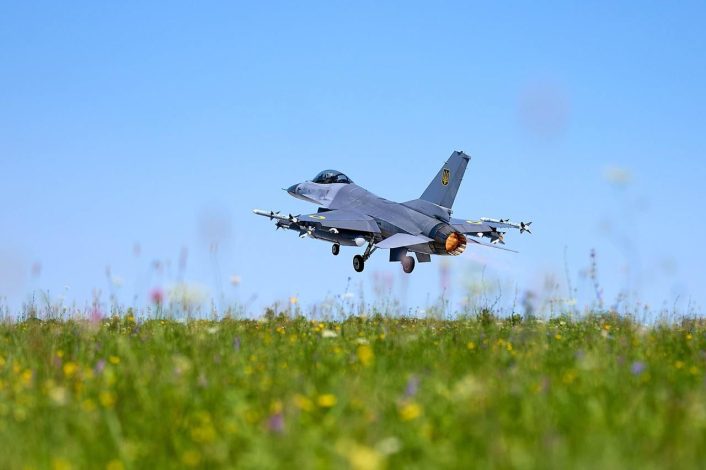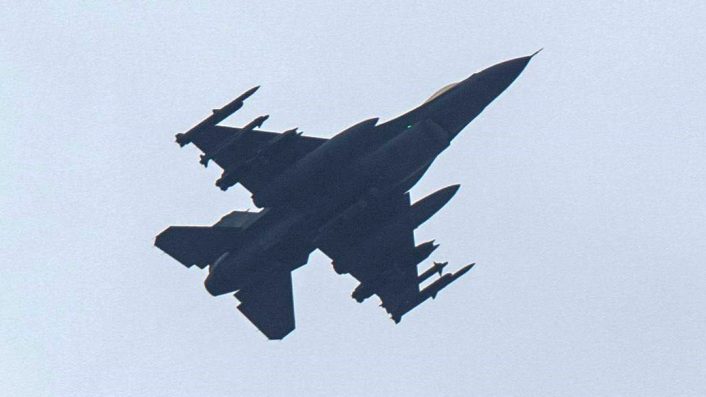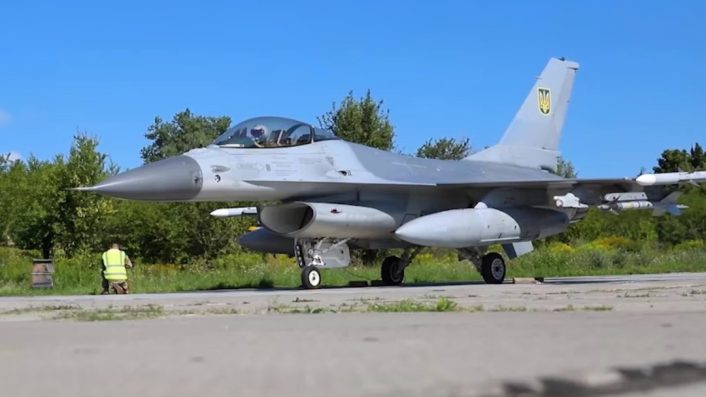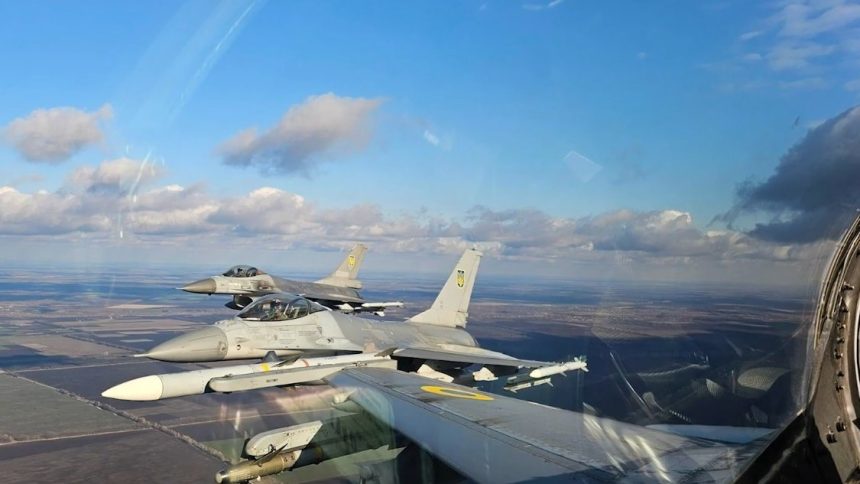Although they are still in limited numbers, Ukrainian Vipers are flying daily defensive and offensive missions.
General Christopher G. Cavoli, the Chief of the U.S. European Command (EUCOM) and Supreme Allied Commander Europe, said that Ukrainian F-16s are flying daily as part of both defensive missions against Russian attacks and offensive missions against Russian targets. The revelation was part of the General’s testimony to the Senate Armed Services Committee last week.
“They fly every day; they’ve defeated large number of cruise missile threats, and they’ve delivered an awful lot of offensive attacks as well, specifically bombing attacks in the east,” said Cavoli. While the U.S. is mediating for a ceasefire, the fight is still raging in the war-torn country.
Ukraine is periodically receiving new batches of the U.S.-made fighter donated by European country, with the latest delivered in mid-March. It is unclear, however, how many have been delivered so far, as well as how many have been lost.

Gen. Cavoli could not comment on the numbers, however he acknowledged that more will be delivered soon. “There are more F-16s prepared to be deployed there,” said Cavoli. “There are more pilots in the training pipeline.”
The volume of flight missions conducted by the Ukrainian Vipers is also demonstrated by the increased number of sightings, with photos and videos surfacing from time to time on social media. The Western fighter is also being prominently featured on Ukrainian official channels.
F-16s Ukrainian Air Force in the skies of Ukraine 🫡 pic.twitter.com/2CzzE8OhP8
— Ukrainian Air Force (@KpsZSU) March 28, 2025
F-16 pilot interview
Last month, the Ukrainian Air Force released an interview with an F-16 pilot, providing few more insights. The pilot expressed satisfaction with regards to the F-16’s capabilities as well as its weapons, which have proved to be highly reliable and accurate.
“Almost every missile hits its target,” the pilot said. “More than 80 percent of the missiles we launch hit their targets, destroying both Shahed drones and cruise missiles launched from sea, air, and land.”
Ukrainian Air Force F‑16 pilot 🫡 pic.twitter.com/Zu2mPOWtsO
— Ukrainian Air Force (@KpsZSU) April 7, 2025
The Vipers are flying multiple missions daily, in cooperation with the other Ukrainian aircraft, including the recently delivered Mirage 2000s. These missions include both defensive and offensive counter air missions, as well as ground attacks.
Ukrainian Air Force fighter jet Mirage-2000s, provided by 🇫🇷 France to 🇺🇦Ukraine, shoot down X-101 cruise missiles in Ukrainian skies, during a russian attack on March 7, 2025!
Thank you to our partners! pic.twitter.com/ndYbfgL8Kx
— Ukrainian Air Force (@KpsZSU) March 7, 2025
The goals of the Ukrainian F-16s’ operations are the protection of critical infrastructures, cities and assets, as well as the strikes against ground targets at “tactical depth” in Russian and occupied territories. While the weapons have not been mentioned, recently the Ukrainian F-16s were spotted with GBU-39/B Small Diameter Bombs.

A bigger goal is to completely prevent the Russian from using guided bombs and performing attacks. Here is an excerpt from the interview:
“Our main focus right now is on Russian use of guided aerial bombs. Not all [zones] are fully covered, but we do our best to complete missions in these areas. We understand that we cannot get close enough to destroy the carriers of these bombs, but a complex effort is underway.
This includes electronic warfare measures to disrupt the operation of these bombs, optimizing the electronic warfare environment, and enhancing the detection field for both the [delivery platforms] and the guided bombs themselves.
We are fully aware that the current number of Western-made air defense systems is insufficient, which is why the issue of increasing their supply has been raised multiple times.
In my opinion, some fronts are suffering from this shortage simply because it is physically impossible to set up this process [but] our defense forces are doing incredibly hard work there, constantly countering both the carriers and the weapons themselves.”
One of the main concerns lately was the interruption of the supply of intelligence data, however the pilot mentioned that he regularly receives real time intelligence without problems. Ukrainian aircraft also fly frequent reconnaissance mission to obtain the data for accurate planning of the attack missions.
“We know our targets in advance – our intel is working quite well, despite media claims that we do not receive intelligence data.,” said the pilot. “You could say our intel forces adapt very quickly, and we receive up-to-date information.”
F-16 in Ukrainian Air Force service
After a prolonged wait, Ukraine finally received the initial delivery of F-16s from the international fighter jet coalition at the end of July. The news of the arrival of the jets in Ukraine was first reported by Bloomberg on July 31, 2024, and was later confirmed by a U.S. official to the Associated Press.
On Aug. 4, 2024, President Volodymyr Zelensky announced the arrival of Ukraine’s first batch of F-16 fighter jets. The delivery was celebrated with a private ceremony at an undisclosed location, where the aircraft were displayed alongside Zelensky and flew in formation overhead.

Around 85 F-16s (91 according to some reports) have been promised to Ukraine, of which 24 from the Netherlands, 19 from Denmark, 12 from Norway and 30 from Belgium. Ten more aircraft will be provided for spare parts by Norway.
The first F-16s transferred to Ukraine, reportedly a total of six aircraft, were from Denmark. A second batch was reportedly delivered in early December 2024, according to Ukrainian President Volodymyr Zelenskyi, with Defense Minister Rustem Umerov saying that Denmark has already handed over “most of the promised F-16s,” with the last batch to be delivered soon.
Early in February 2025, the Ukrainian government also acknowledged the delivery of a new batch of F-16s, this time from the Netherlands. Zelensky announced the arrival of the latest batch of aircraft on Mar.19, without providing details about their number or origin.
Photos released by the Ukrainian Air Force showed the jets equipped with Terma PIDS+ (Pylon Integrated Dispensing System) pylons, which also include UV Missile Warning Sensors. The pods in question have been fitted onto wing stations 3 and 7 and allow for increased chaff and flares capacity, as well as IR-guided missile’s approach warning.
In August 2024, shortly after the delivery, the U.S. Air Force disclosed its involvement in the upgrade of the electronic warfare (EW) suites of the Ukrainian F-16s. The service collaborated with Denmark and the Netherlands to develop, test and deliver full-spectrum Electromagnetic Warfare support.

To effectively integrate the F-16 into the Ukrainian Air Force, its EW subsystems required reprogramming to be effective against evolving Russian threats in the spectrum, said the press release. The service explicitly referred to a “reprogrammed pod,” possibly hinting at the ALQ-131 ECM pod seen in the photos.
The F-16s delivered to Ukraine are already compatible with many of the Western weapons that were integrated on the Ukrainian MiG-29s and Su-27 and will be able to employ these weapons more efficiently. Unconfirmed reports mention that Ukrainian F-16s might also get in future the possibility of employing the AGM-158 JASSM.
The versatile, multirole F-16 jets will augment and eventually replace Soviet-era fighters, which have been modified to use Western-donated weapons like the JDAM (Joint Direct Attack Munition), AGM-88 HARM (High-Speed Anti-Radiation Missile), ADM-160 MALD (Miniature Air-Launched Decoy), and the Storm Shadow/SCALP-EG ALCM (Air-Launched Cruise Missile), though these modifications have faced some difficulties.









